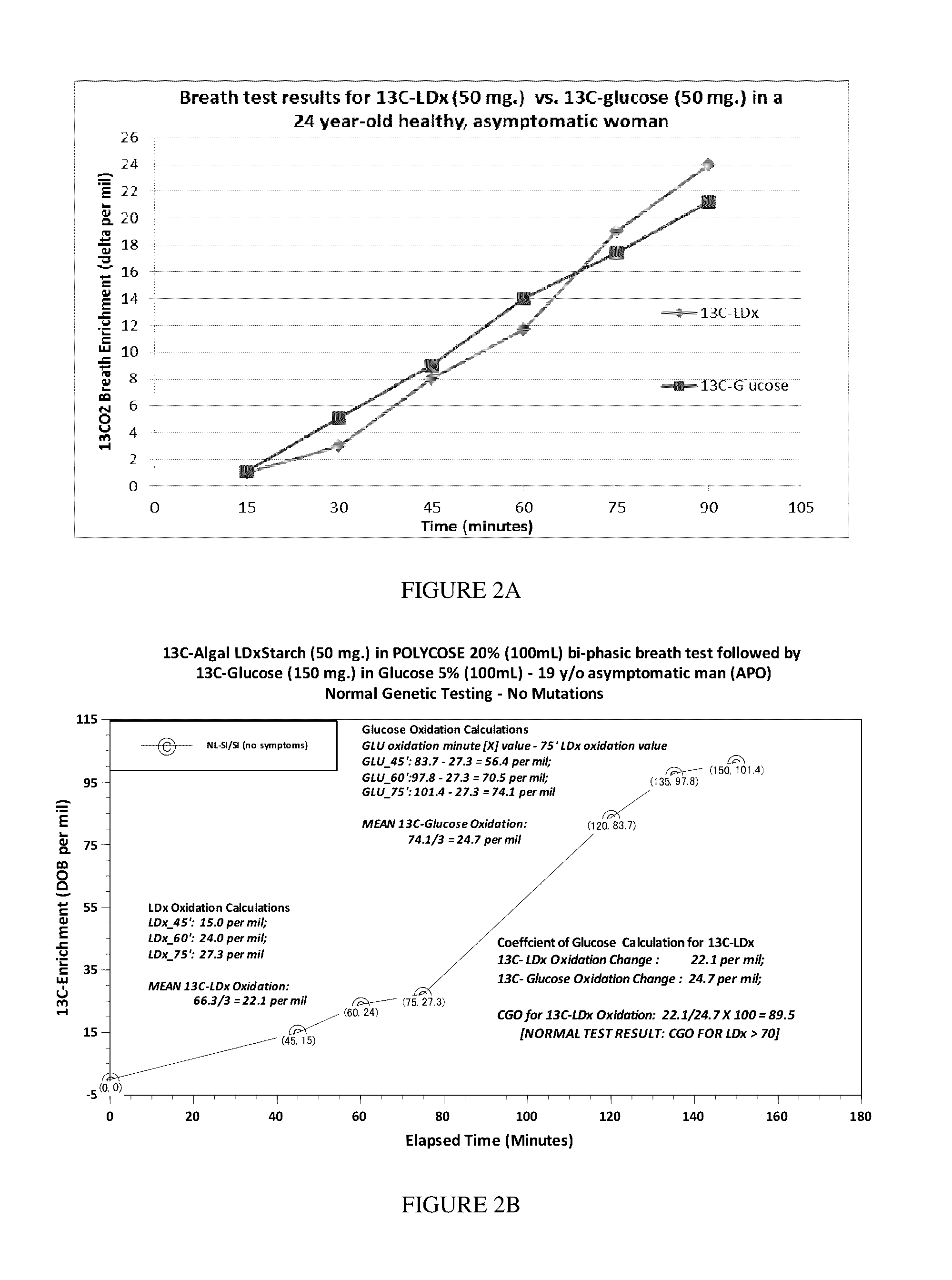13c labeled starch/alpha limited dextrins digestion breath test
a technology of alpha-limited dextrins and labeled starch, which is applied in the field of molecular biology, biochemistry, chemistry, nutrition and medicine, can solve the problems of affecting the activities of daily life, reducing the quality of life, and putting a significant burden on society, and achieves the effects of low enzyme activity, low enzyme production, and impaired digestion of carbohydrates
- Summary
- Abstract
- Description
- Claims
- Application Information
AI Technical Summary
Benefits of technology
Problems solved by technology
Method used
Image
Examples
example 1
Clinical Procedure and Technique
[0090]A two-part carbohydrate oxidation breath test is performed, first using uniformly labeled 13C-glucose as the substrate. Patients provide up to 8 breath samples for isotopic enrichment analysis by inflating (blowing into) a bag (each labeled with subject identifiers, date, time and substrate used). The substrate (50 mg) is dissolved in a 100 mL 20% solution of edible soluble starch (Polycose®) and is ingested after collection of the first breath sample (reference-baseline sample, 2 liter) using a foil-lined bag fitted-up with a one-way valve mouthpiece and a double-sealing cap. Subsequent timed test breath samples are collected (250 mL each) at 30, 45, 60, 75, 90, 105 and 120 minute intervals. The following day or 24 hour period, the breath test is repeated in similar fashion, except that the glucose substrate is substituted with uniformly labeled 13C-starch (10 mg). In some examples, the uniformly labeled 13C-starch is derived from edible photos...
example 2
Assessment of Starch Digestion Capacity
[0091]An easy and functional assessment of downstream disaccharide digestion was needed to determine the short-term response to enzyme dietary supplementation and to signal when mucosal function is at fault. Ethical issues and costs make non-invasive BTs after feeding stable-isotope labeled (non-radioactive) carbohydrates an attractive alternative or adjunct to duodenal biopsies for enzyme assays at EGD procedures. A panel of non-invasive breath tests were developed using non-radioactive 13C-starch, 13C-partially hydrolyzed starch (13C-α-LDx), 13C-sucrose and 13C-glucose substrates that appear promising for clinically measuring deficient starch or sugar digestion at the mucosal level. The digested and absorbed glucose from the 13C-starch substrate is oxidized and appears in the breath and is compared to a paired BT of absorbed 13C-glucose with the same 13C-enrichment. Efficient crude 13C-starch digestion and oxidation closely (normally) paralle...
example 3
Normal Limits of 13C-Alpha-Limit Dextrin Breath Test
[0097]Salivary and pancreatic α-amylases both partially hydrolyze starch by cleaving only internal α-1, 4 glycosyl linkages to three basic types of molecules: maltose (two glucose units with one bond), maltotriose (three glucose units with two bonds), and α-LDx (short glucose chains consisting of α-1, 4 glycosyl linkages with a limited number of residual branching α-1, 6 glycosyl linkages). The length of the α-LDx chain may be longer if the reaction is not allowed to go to completion in vitro. α-LDx are so named because they are digested to the limit to which α-amylase can digest starch. These “limited” products of digestion by amylase are oligosaccharides and disaccharides that are then subsequently hydrolyzed to glucose at the mucosal surface of the small intestine. The benefit of using α-LDx is the elimination of the confounding variable of pancreatic alpha amylase activity in the digestion of complex luminal starch. With the α-...
PUM
| Property | Measurement | Unit |
|---|---|---|
| atomic mass weight | aaaaa | aaaaa |
| atomic mass | aaaaa | aaaaa |
| atomic mass | aaaaa | aaaaa |
Abstract
Description
Claims
Application Information
 Login to View More
Login to View More - R&D
- Intellectual Property
- Life Sciences
- Materials
- Tech Scout
- Unparalleled Data Quality
- Higher Quality Content
- 60% Fewer Hallucinations
Browse by: Latest US Patents, China's latest patents, Technical Efficacy Thesaurus, Application Domain, Technology Topic, Popular Technical Reports.
© 2025 PatSnap. All rights reserved.Legal|Privacy policy|Modern Slavery Act Transparency Statement|Sitemap|About US| Contact US: help@patsnap.com



